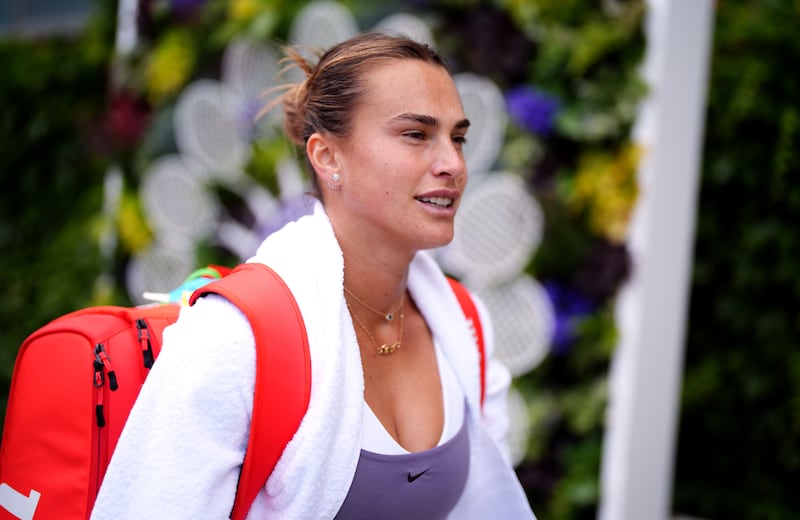Over the past couple of years a curious divide has opened up on the women’s tour. The rankings, on one hand, do not lie. Iga Swiatek, the world number one, has been the best player across all events the past 52 weeks, rightfully earning her place at the summit by consistently sweeping up big titles across hard courts and clay in addition to her half-decade dominance at Roland Garros.
But at the grand slams, the ones that matter most, there is a slightly different order these days. Aryna Sabalenka, the world number two, has now reached the finals of the past four hardcourt majors and she has made her presence felt at the semi-final stage or better in seven of the past eight she has competed in. It is just as clear she is the best in the world at the grand slam tournaments and on Saturday she will attempt to capture her third such title in two years.
It has been remarkable to see the Belarusian evolve from one-dimensional and ultra-attacking into a more thoughtful, refined player who better understands how to harness her awesome power and properly construct points. She has learned to opt for slightly higher percentage decisions even while still pulverising the ball and has added more dimensions to her game, mixing in a greater variety of shot.
Although she still plays with the same burning fire, the 26-year-old has also learned how to keep a calmer head in distress. When everything seemed to be falling apart in the second set of her semi-final match against Emma Navarro, Sabalenka remained composed and pulled herself together in a remarkable tie-break by breaking down Navarro’s formidable defences, mixing in smart, well-executed drop shots and net approaches alongside her typically brutal ball-striking.
READ MORE
She will draw upon all of those improvements in the final that will pit the two most in-form players of the North American hardcourt swing against each other again. While surprise results and upsets in the women’s grand slam draws over the past decade have often provided a happy contrast to the more orderly men’s tour, this year the tables have turned. The results in New York have simply replicated the pecking order in the weeks leading up to it.
Coming into the US Open, the changing fortunes of Sabalenka and Jessica Pegula were the two significant stories. After a difficult season due to neck and back injuries, which forced her to miss the entire clay season, the American found her feet on the hard courts of Toronto by winning the Canadian Open WTA 1000 tournament in August, which she followed up by reaching the final of the Cincinnati Open. She lost in that final against Sabalenka, who rediscovered her form after being forced to withdraw from Wimbledon with a shoulder injury. They will now resume their rivalry on the biggest stage in tennis.

While Sabalenka’s major tournament record is remarkable, those runs have often also underlined her vulnerabilities. For all of the grand slam matches she has won over the last few years, she could have won even more major titles if not for her tendency to collapse in big matches. Two years ago, Sabalenka led Swiatek 4-2 in the final set of the US Open semi-final before losing the final four games. She then held a match point against Karolina Muchova at 5-2 in the final set of their 2023 French Open semi-final then lost five games in a row. At Wimbledon, she led Ons Jabeur 7-6 (5), 4-2 in another semi-final before losing four successive games and eventually the match. Last year in the US Open final, she allowed the deafening crowd to get under her skin and she crumbled after winning the opening set.
In her first grand slam final, Pegula has a difficult task against an opponent who hits a considerably bigger ball and is capable of hitting her off the court. In recent years, Sabalenka has seemed to enjoy the consistent, flat ball that the world number six provides and leads their head-to-head 5-2. Pegula’s only win over the past four years came in torrential winds at the WTA Finals last year.
It will be up to Pegula (30) to make her opponent uncomfortable by continuing to take the ball early, pouncing on second serves and maintaining her typically excellent depth throughout the match. She showed in her excellent semi-final comeback win over Muchova that she can remain mentally tough in the tight moments. Now she has the challenge of using the home crowd to her advantage and exposing Sabalenka’s mental vulnerabilities as well as she can while remaining in control of her own emotions in the biggest moment of her 15-year career. - Guardian
- Sign up for push alerts and have the best news, analysis and comment delivered directly to your phone
- Join The Irish Times on WhatsApp and stay up to date
- Listen to our Inside Politics podcast for the best political chat and analysis













